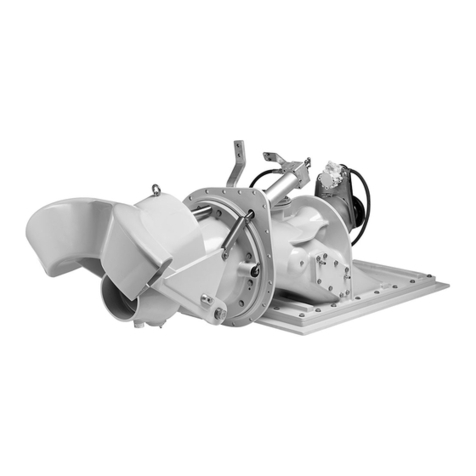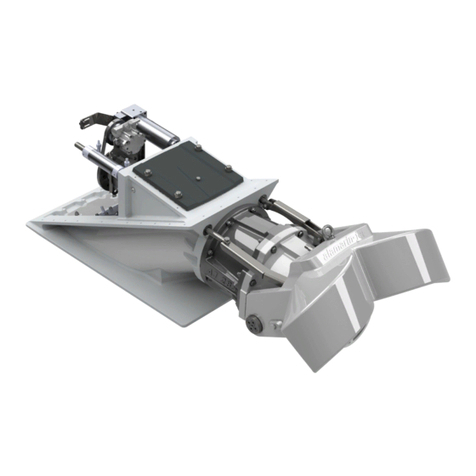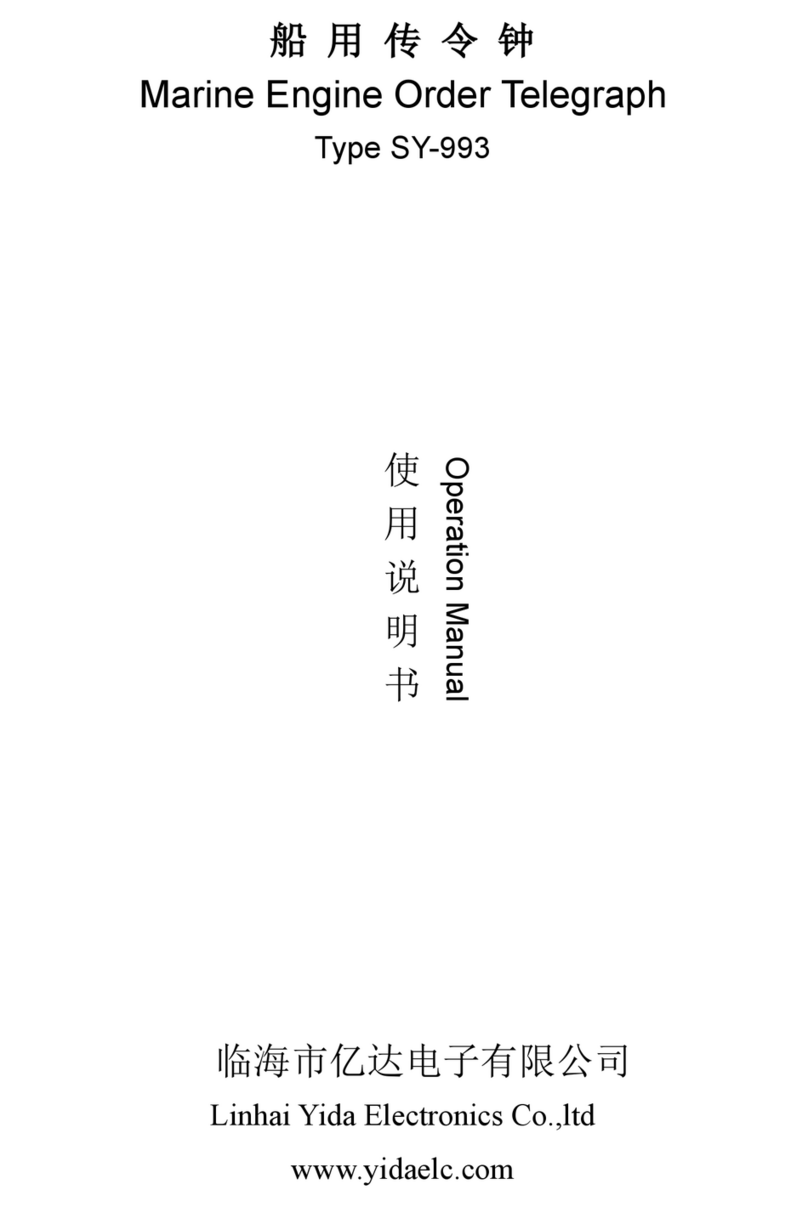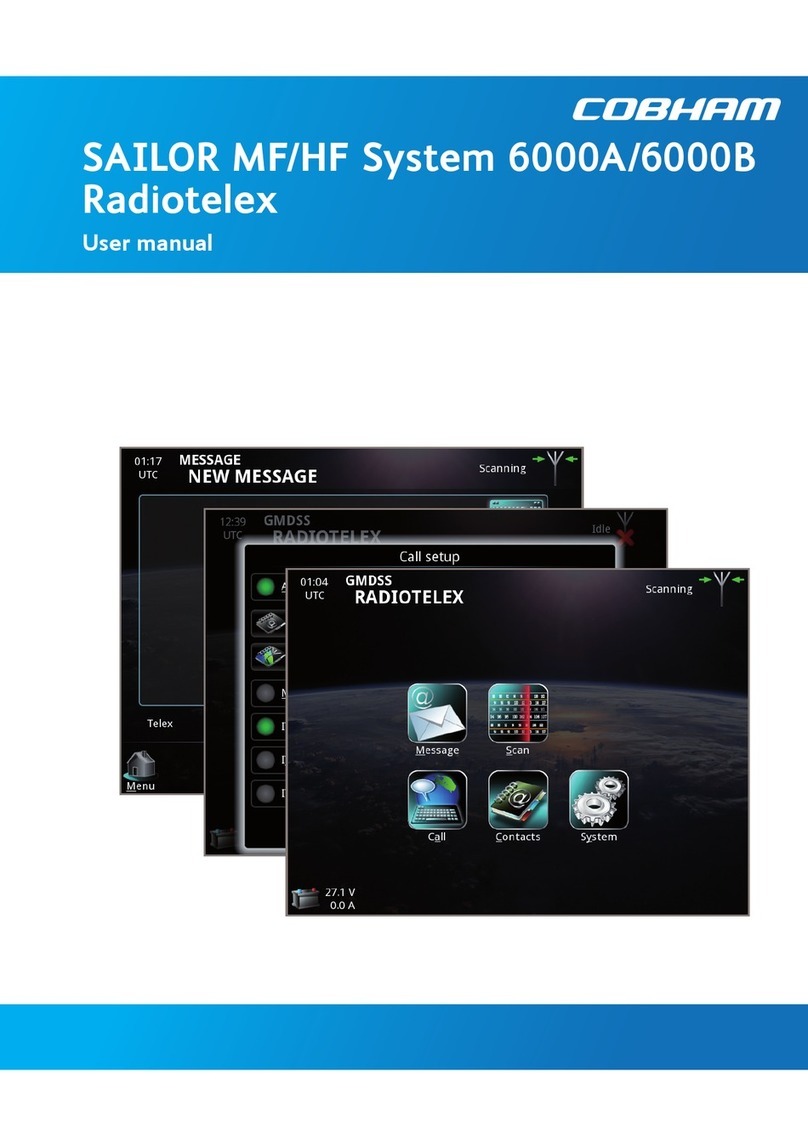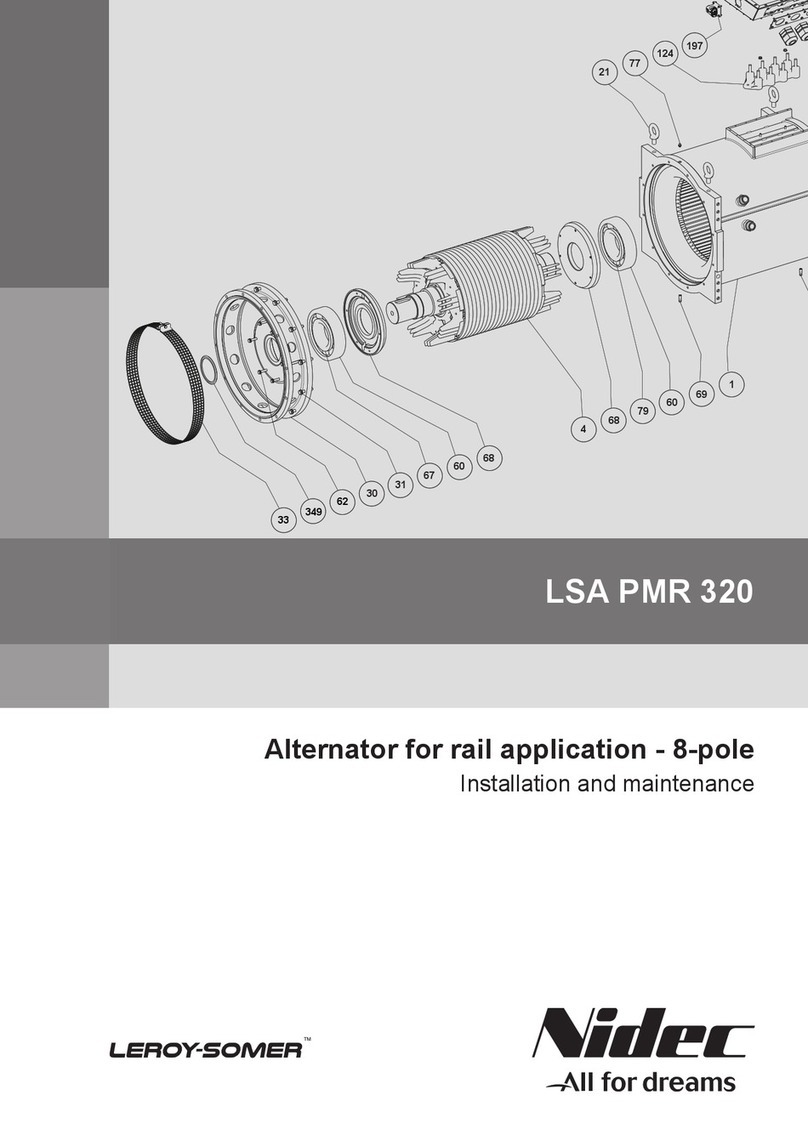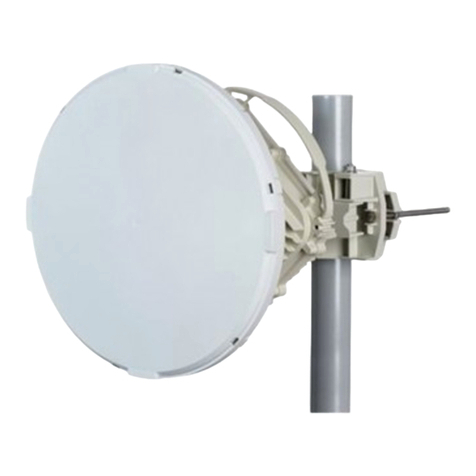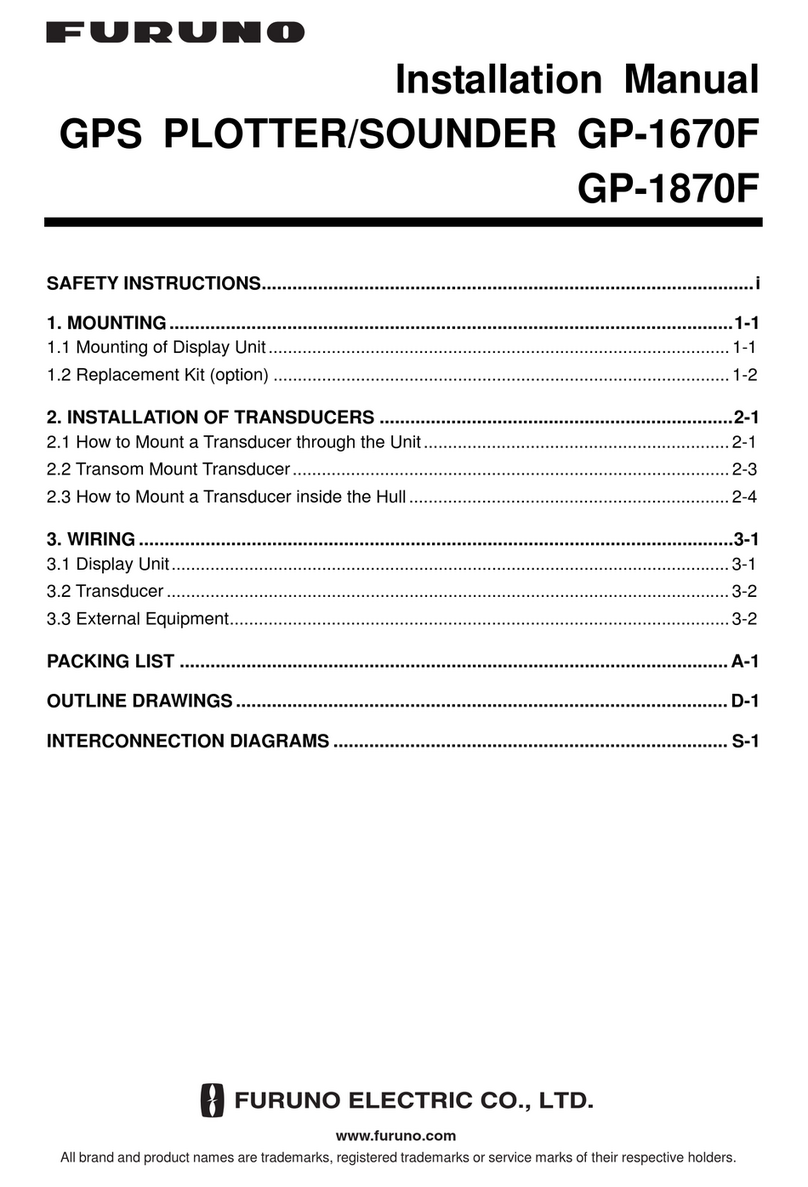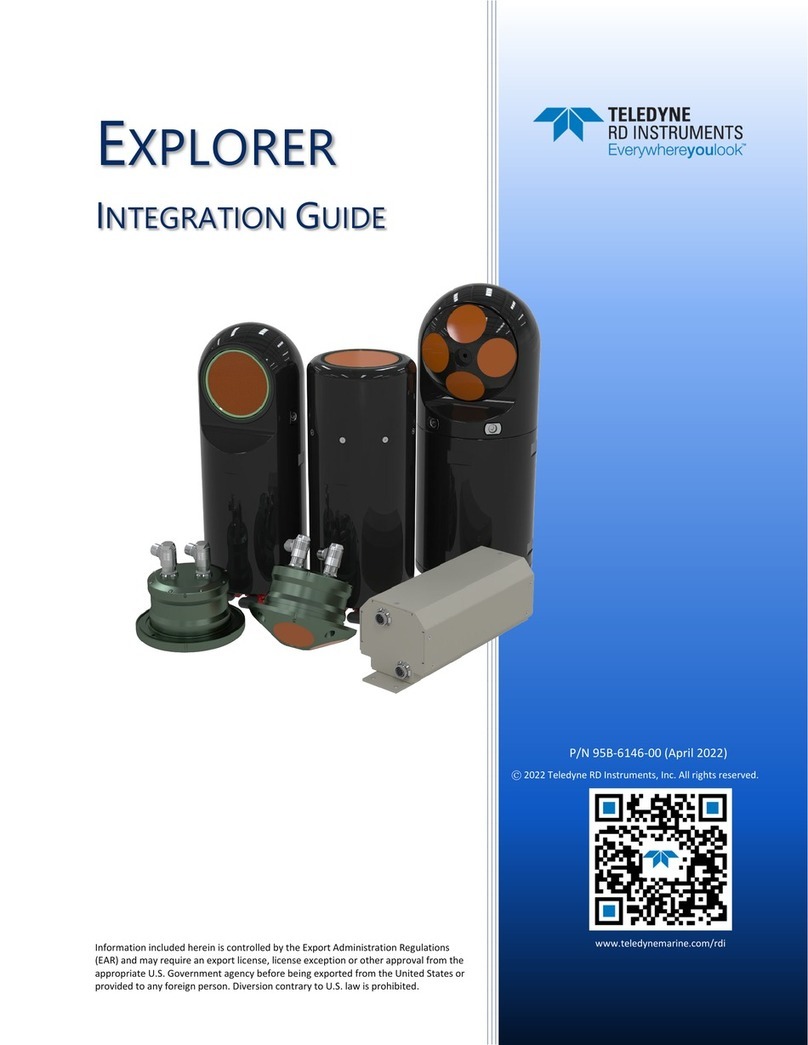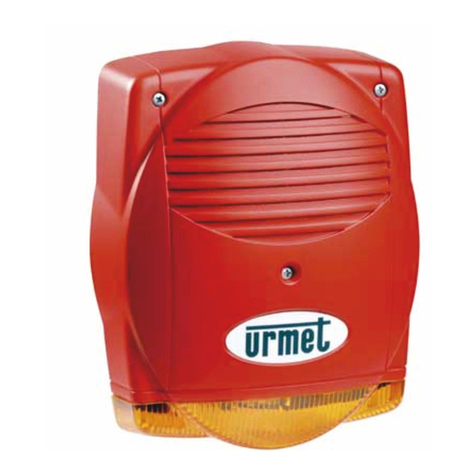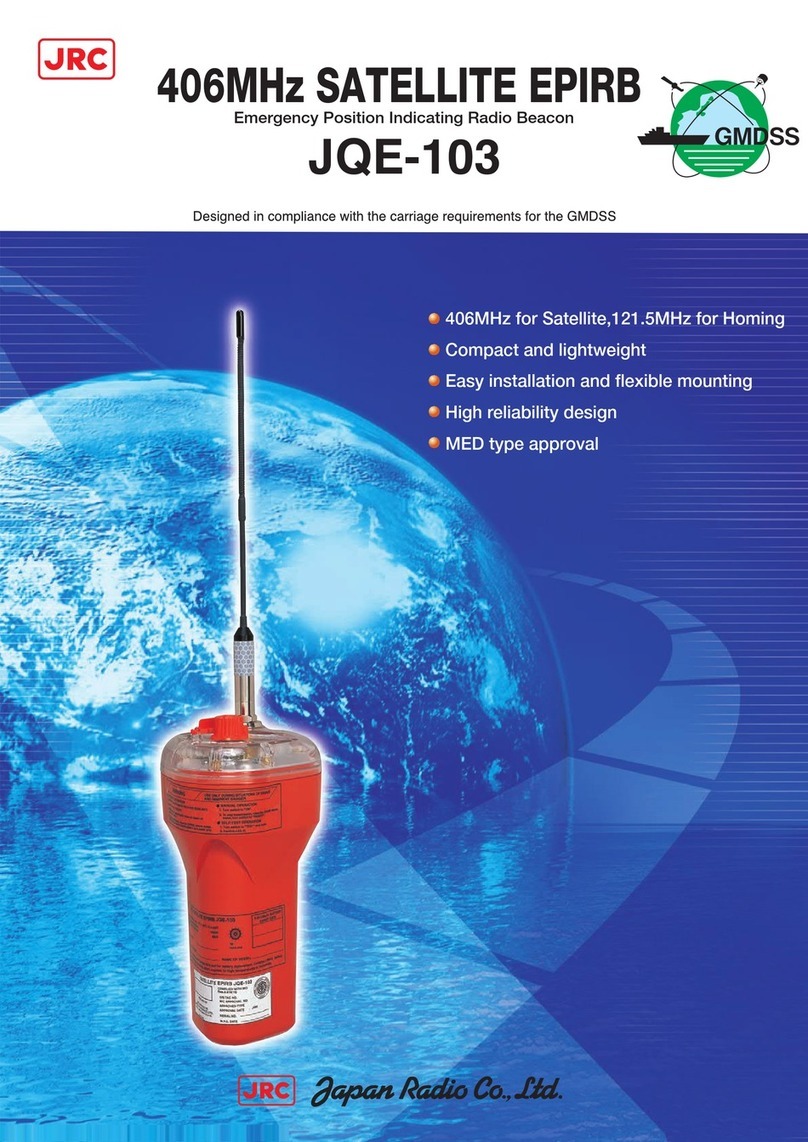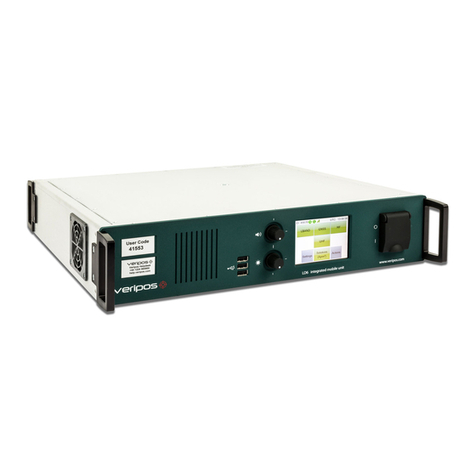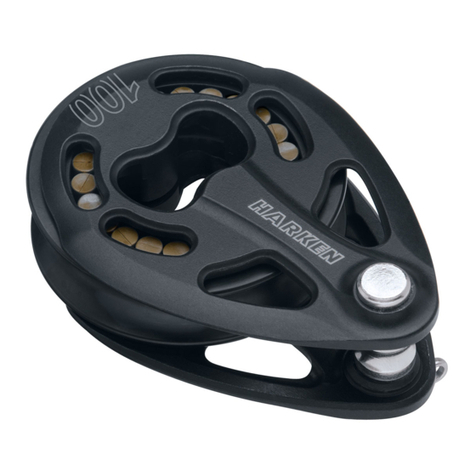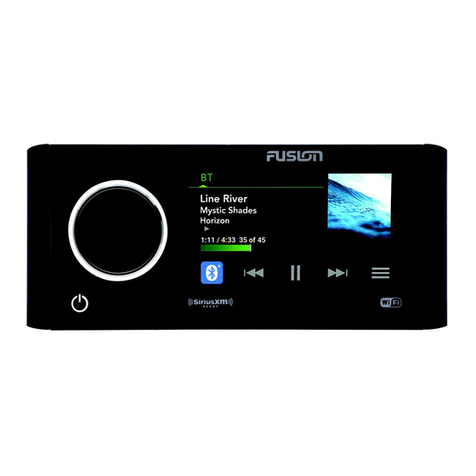Alamarin Jet AJ 160 User manual


Operation and Maintenance Manual
22
Version 1.5
2
We congratulate You on purchasing a new
alamarin-jet
water jet propulsion unit and
hope that you can enjoy it.
Alamarin-Jet Oy has developed and manufactured water jet propulsion units since 1976.
The propulsion units are used e.g. in pleasure and work boats, as well as in fast rescue
boats with a number of different engines. Thousands of users around the world rely on
the
alamarin-jet
water jet propulsion unit.
The aim of this instruction is to give important information on the operation, use and
maintenance of the unit. We recommend reading this manual carefully before the
implementation of the unit and before You set out to test Your new jet boat for the rst
time. This is how You get the most pleasure and benet out of it.
With best regards,
Alamarin-Jet Oy
Tuomisentie 16
62300 Härmä
Finland
tel. +358-10-7745 260
fax. +358-10-7745 269
www.alamarinjet.com

3 Operation and Maintenance Manual
Version 1.5 Version 1.5
alamarin-jet
water jet propulsion unit
OPERATION AND MAINTENANCE MANUAL
Alamarin-Jet Oy has published this manual in order to guide the owners and users of
boats equipped with
alamarin-jet
water jet propulsion unit.
Alamarin-Jet Oy has published other manuals separately for technical designers,
mechanics and repair men.
From here on in this manual the
alamarin-jet
water jet propulsion unit will be
referred to as ”jet”. This term refers exlusively to a propulsion unit manufactured by
Alamarin-Jet Oy.
The instruction covers the following jet propulsion models:
AJ 160 AJ 180 AJ 185 AJ 230
If the given information is type specic, this will be expressed in the text.
In this manual, clarifying gures will be used.
NOTE - the text includes a warning of a slight danger or a possibility of minor damage to
equipment
HINT - the text includes useful additional information or a hint which facilitates the work
performance or procedure
STOP
!
SERIOUS DANGER - the text includes a warning of danger to life
WARNING - the text includes a warning of a danger that can lead to personal injury, breaking
down of equipment or serious malfunction of equipment
WARRANTY
GUARANTEE MATTER - the text includes a guarantee clause
The symbols used in the manual:
ARROW DESCRIBING MOTION
INDICATOR ARROW
XPART MARKING

Operation and Maintenance Manual
44
Version 1.5
4
After Sales Questionnaire....................................................................................6
Declaration of Incorporation for Partially Completed Machinery .........................8
1. The Jet Propulsion Unit...................................................................................9
2. Operation.......................................................................................................10
2.1. Using for the First Time..........................................................................10
2.2. Steering and Controlling.........................................................................11
...2.2.1. Steering...........................................................................................12
...2.2.2. Controlling.......................................................................................12
2.3. Operating in Shallow Water....................................................................14
2.4. Operating in Reedy Water......................................................................15
2.5. Dry running.............................................................................................16
2.6. Cavitation and Ventilation......................................................................16
...2.6.1. Cavitation........................................................................................16
...2.6.2. Ventilation .......................................................................................17
3. Functions.......................................................................................................18
3.1. Transmission..........................................................................................18
3.2. Bearing...................................................................................................19
3.3. Control System.......................................................................................19
...3.3.1. Electronic Reversing Deector Control System ..............................19
...3.3.2. Hydraulic Reversing Deector Control System...............................20
3.4. Raw Water Cooling ................................................................................22
3.5. Corrosion Protection ..............................................................................22
...3.5.1. Cathodic Protection.........................................................................22
...3.5.2. Painting...........................................................................................23
4. Maintenance..................................................................................................24
4.1. Tools.......................................................................................................24
4.2. Periodical Maintenance..........................................................................24
...4.2.1. Washing the Jet ..............................................................................25
...4.2.2 Lubricating the Bearings..................................................................25
...4.2.3. Lubricating the Control System.......................................................26
...4.2.4 Changing the Zinc Anodes...............................................................27
...4.2.5. Adjusting the Impeller......................................................................27
...4.2.6. Checking the Seals.........................................................................27
...4.2.7. Maintenance of the Hydraulic System ............................................27
4.3. The Impeller ...........................................................................................29
...4.3.1. Removing the Impeller....................................................................31
...4.3.2. Fitting the Impeller ..........................................................................33

5 Operation and Maintenance Manual
Version 1.5 Version 1.5
APPENDIXES
Appendix 1. Maintenance Log............................................................................... 35
Appendix 2. SE-01................................................................................................. 36
Appendix 3. SE-02................................................................................................. 37
Appendix 4. Recommended Greases and Oils and Tightening Torques
of the Screws .................................................................................... 38
Appendix 5. Exploded Views................................................................................. 39
Appendix 6. Warranty & Ownership ...................................................................... 40

AFTER SALES QUESTIONNAIRE
66 6
Version 1.5
AFTER SALES QUESTIONNAIRE
In order to improve our products and operations, we at Alamarin-Jet Oy are
collecting feedback from the end users of water jet propulsion units. This form
is intended to make it as simple as possible for you to give us that feedback.
You can ll out the form in the User’s Manual and send it to us via mail or fax,
or scan and send it via e-mail.
Only answer questions to which you know the answer.
Customer’s/end user’s contact information:
(Boat owner)
Contact information of person answering the questionnaire:
Delivery information of project/device:
(For instance the serial number of the propulsion unit or other relevant
document)
Test information for ALAMARIN-JET:
(Use table on the next page)
Customer service received from retailer/importer/manufacturer prior to
delivery:
(Quotation, technical guidance, documentation, etc.)
Delivery of propulsion unit:
(Timeliness of delivery, contents of delivery, packaging, documentation)
After sales services:
(Include prior experiences of retailer’s/manufacturer’s services)
Spare parts services:
Other comments:

7 AFTER SALES QUESTIONNAIRE
Version 1.5
Version 1.5
Return address: ALAMARIN-JET OY
Tuomisentie 16
FI-62300 HARMA
FINLAND
EUROPE
Fax: 00 358 10 7745 269
E-mail: [email protected]
TEST REPORT Date:
Test weight of boat Number of persons Wind speed m/s Water temperature
Jet serial number Engine and gear GPS/clock Signature
Engine speed Speed in direction 1 Speed in direction 2 Average speed
2400
2500
2600
2700
2800
2900
3000
3100
3200
3300
3400
3500
3600
3700
3800
3900
4000
4100
4200
max rpm
Notes:
If possible, include pictures in your feedback.

Operation and Maintenance Manual
88
Version 1.5
8
DECLARATION OF INCORPORATION FOR PARTIALLY
COMPLETED MACHINERY
(Machinery Directive 2006/42/EC, Annex II, 1.B.)
Manufacturer: Alamarin-Jet Oy
Tuomisentie 16
FI-62300 Härmä, Finland
Compiler of the technical le: Hannu Rantala, Technical Manager
Alamarin-Jet Oy
Tuomisentie 16
FI-62300 Härmä, Finland
Description of the partially completed
machinery: Water jet propulsion device
Operation of the partially completed
machinery: The device is intended to be used as the
propulsion device of a motor boat. A
propulsion device transforms the torque
of the motor into propulsive force.
Model and type of the partially
completed machinery: ____________________________
Serial number of the partially
completed machinery: ____________________________
Alamarin-Jet Oy guarantees that the abovementioned partially completed
machinery meets the requirements of the Machinery Directive (2006/42/EC) and
the validating national regulations.
In addition, the company guarantees that
- the specic technical documents related to the partially completed machinery
have been created according to section B of Annex VII in the Machinery
Directive (2006/42/EC), and
- the following harmonised standards are applied: SFS-EN-ISO 12100-1 and
SFS-EN-ISO 14121-1.
Alamarin-Jet Oy also undertakes to deliver the documents related to the
partially completed machinery to the relevant national authority in electronic
format if so requested.
The partially completed machinery must not be introduced to use before the
nal equipment to which it is intended to be attached has been declared to
conform to the requirements of this Directive.
Place: Kauhava, Finland
__________________________
Date and Signature

9 Operation and Maintenance Manual
Version 1.5 Version 1.5
1. The Jet Propulsion Unit
Alamarin-jet water jet propulsion unit is a single stage axial ow pump, which produces
a high volume ow rate and thrust with high efciency.
The operation of the unit is based on increasing the water ow rate in the nozzle. The
change in the ow rate creates a reacting force in the direction of the ow, which thrusts
the boat forward. By changing the direction of the jet, it is possible to steer the boat in
the desired direction.
Main Parts (gure 1-1):
The intake duct (A), whose
function is to lead the water from
outside the boat to the intake
side of the impeller with as little
loss as possible and an even
distribution of velocity.
The impeller (B), which is
rotated by the driving motor
through direct drive, increases
the water’s ow rate.
The nozzle converts the pressure
energy produced by the impeller
to motion energy.
The steering device (C) is used
to change the direction of the jet
ow coming out of the nozzle,
which creates the force needed
for turning.
The controlling device (D)
Lowering the reversing deector
causes the boat to reverse. The
direction of the jet ow changes
obliquely forward under the
boat, which is when the thrust
is directed forward and down.
The reversing deector is also
used for stopping the boat. See
section: Steering and Controlling,
page 10
Figure 1-1
B
A
D
C

Operation and Maintenance Manual
1010
Version 1.5
10
Before you set the boat aoat for the rst time, make sure that the jet
has been installed according to the Installation Instruction.
This prevents the emergence of unexpected fault situations which can
lead to damages.
2. Operation
2.1. Using for the First Time
Starting:
In starting an engine equipped with the jet, the following things should be observed:
- The reversing deector control lever must be in centre position.
- The possible gear must be in ”neutral” position.
- In a system without a gear the accelerator must be in ”idle” position.
See the effect of the position of the reversing deector control lever on the position of
the reversing deector on page 11.
Every propulsion unit has its own
serial number. The serial number has
been marked on the type label and in
addition it has been stamped both on
the body of the propulsion unit and on
the inspection hatch cover.
The places in which the serial number
can be found have been designated in
gures 1-2 and 1-3. The serial number
has also been recorded on page 8 of the
Instructions for Use and Maintenance.
Figure 1-2
Figure 1-3

11 Operation and Maintenance Manual
Version 1.5 Version 1.5
When you start the engine for the rst time:
- It may be possible that ”clinking” is heard from the jet during the rst minutes. This
should usually disappear, however, when the impeller gap becomes t.
- The reversing deector’s hydraulic control system needs more oil because the hoses
and cooler are empty. The oil pump noise may be loud at rst, but as the system lls up
with oil the noise disappears. Observe the oil level in the beginning because leakages
cause environmental pollution.
- Checking the oil level has been described in section 3.3.2. The oil type has been given
in appendix 4.
- Ensure the functioning of the system carefully, at low speeds.
- Observe the engine manufacturer’s instructions on running in. The jet does not
require special running in.
- In a system that includes a gearbox, note the direction of the jet´s rotation, which
usually corresponds to the direction of the engine´s rotation (counterclockwise from the
rear of the boat). This is why the gear must usually be used in the ”reverse” position
when you want to engage the propulsion unit´sdrive.
WHEN THE ENGINE IS STARTED UP, THE INTERMEDIATE
SHAFTAND THE MAIN SHAFT START TO ROTATE. AT THIS
STAGE, IT IS NOTALLOWED TO GO NEAR THE ROTATING
PARTS!
THE INSPECTION HATCH MUST BE KEPT CLOSED WHILE
THE ENGINE IS RUNNING!
2.2. Steering and Controlling
IN THIS SECTION, CONTROLLING THE jet boat IS DESCRIBED
IN AWAY THAT IT IS DONE THROUGH ASYSTEM THAT HAS
BEEN INSTALLED AS INTENTED BYTHE MANUFACTURER.
Alamarin-Jet Oy IS NOT LIABLE FOR DAMAGES WHICH
DERIVE FROM INCORRECT INSTALLATION OF THE SYSTEM.
WARRANTY
Steering denotes exclusively moving the steering nozzle. Steering means changing the
boat’s bow angle.
Controlling denotes exclusively moving the reversing deector. Controlling means
changing the boat’s driving direction (forward - astern).

Operation and Maintenance Manual
1212
Version 1.5
12
Figure 2.2.1-1
2.2.1. Steering
The boat is steered by turning the steering wheel. The connection from the wheel to the
steering lever can be either mechanical or hydraulic (gure 2.2.1-1). The lever moves
the nozzle through the shaft and the joint.
- Steering is possible when the power of the jet ow is sufcient. This is why the
engine must run on sufciently high revs when steering. 1200-1800 rpm is a suitable
number of revolutions, depending on the engine.
- In sharp curves, turning the nozzle causes the boat to slow down. This is normal and
increases safety.
- The turning of the nozzle from one extreme position to the other takes ~2 turns of the
wheel.
2.2.2. Controlling
In models AJ 160 andAJ
180/185 a fully mechanical
system can be used, as long as
it is sturdy enough.
The reversing deector can be
lowered in front of the jet ow,
changing its direction forward
and down. There are two
different types of deectors.
Figure 2.2.2-1
Driving direction is controlled with the reversing deector. The reversing deector
is moved with the lever which is usually next to the throttle lever. With this lever, it
is possible to control the hydraulic system mechanically or the mechanical system
electrically.

13 Operation and Maintenance Manual
Version 1.5 Version 1.5
The round type reversing
deector (gure 2.2.2-1) ts in
assemblies in which width is
critical. By using the tube type
reversing deector (gure 2.2.2-
2), a higher reversing power
is attained, but the deector is
wider. The second tube-type
reversing deector model (gure
2.2.2-3) is primarily designed for
twin installations, but it can also
be used for single installations.
Figures 2.2.2-2 and 2.2.2-3
illustrate the hydraulic control
system used in AJ 230.
For models AJ 160 andAJ
180/185, only the round type
reversing deector is available.
Figure 2.2.1-2
When the reversing
deector control lever
is in forward position,
the deector is not
blocking the jet ow
and the boat moves
forward (gure 2.2.2-
4).
When the lever is
in the rear position
(gure 2.2.2-5), the
deector is in front of
the jet ow and the
boat moves astern.
Figure 2.2.2-3
Figure 2.2.2-4
Figure 2.2.2-5

Operation and Maintenance Manual
1414
Version 1.5
14
The centre position of the reversing deector corresponds to gear’s ”idle” position; even
though the drive is on, the boat stays still. The centre position is not absolute, it depends
on the power of the jet ow. Finding the centre position is done by testing during the
rst driving hours.
When moving at low speeds, the reversing deector is used to control the boat’s speed.
Because the engine is being run at 1200-1800 rpm to enhance steering, the boat may
travel faster than desired. In this case the deector is lowered in front of the jet ow
to reduce the thrust directed towards the driving direction. Steerability remains good
however.
At high speeds, the deector is not used to reduce speed. Instead, speed is controlled
with engine revolution.
It is possible to turn the boat in place when the deector is in centre position. When the
nozzle is turned to the desired direction, the boat rotates about its central axis.
When reversing, steering is inversed in comparison to driving forward. If you want to
turn the boat to the left, the wheel must be turned to the right. A good mnemonic is that
the boat’s bow always turns in the same direction as the wheel.
When fast turns are needed, the engine revolutions are not reduced, but instead the turn
is done through combined motion of the nozzle and the deector.
Figure 2.3-1
2.3. Operating in Shallow Water
The jet boat can be used in very shallow water, but it must be taken into account that
especially on high revolutions the suction power of the intake is high (cf. gure 2.3-1).
Loose objects may get sucked into the intake screen and small objects wash through the
jet. Stones may cause damage. In sandy conditions wearing inevitably takes place. The
maintenance procedures required by a worn impeller are described in the maintenance
section of this manual. See Adjusting and Fitting the Impeller, page 24.

15 Operation and Maintenance Manual
Version 1.5 Version 1.5
At planing speeds, a jet boat usually crosses reed elds without difculty. In difcult
conditions however, clogging may be possible. In boats equipped with a gear box,
cleaning the intake duct is easy because at reverse gear, a back ow is created in the
duct.
2.4. Operating in Reedy Water
THE JET HAS BEEN DESIGNED TO RUN ON REVERSE GEAR
ONLY MOMENTARILYAND ON LOW REVOLUTIONS.A TOO
HEAVY LOAD ON REVERSE GEAR CAN LEAD TO JAMMING
OF THE IMPELLER OR BREAKING DOWN OF HYDRAULICS!
Figure 2.4-1
If clogging occurs on a boat that does not have a gear box, the following procedures are
recommended:
1. Stop the engine. This causes the extraneous objects in the grass rake simply to
drop off.
2. Let the engine run on high revolutions for a few times. This often sucks the
extraneous objects through the jet and cleans it.
3. If the boat is moving forward, raise the boat speed as much as possible and then
shut down the engine. The speed of the boat often sweeps the grass rake clean.
4. Drive the boat on reverse as fast as possible. As the boat moves astern, shut
down the engine and move the deector control lever to forward position.
This causes water to ow backwards through the jet and usually opens any
blockage whatsoever.
The sleeve shown in gure 2.4-1 on the axle has a left-handed threading. If the engine is
run at too high revolutions on reverse gear, the sleeve may loosen and the impeller may
get stuck against the duct walls.

Operation and Maintenance Manual
1616
Version 1.5
16
Figure 2.4-2
The most common malfunction in water jet propulsion units manifests as cavitation.
Engine overdrive and stopping of thrust are signs of this.
Cavitation is a phenomenon in which the water pressure decreases locally in such an
extent that water vaporizes on the surface of the impeller blade, creating steam bubbles.
The bubbles move on the surface of the blade and when they reach a higher pressure
area they collapse. Cavitation incurs considerable reduction in capacity and damages the
impeller.
Usually the cause is the reduction of pressure in the whole intake duct, which is induced
by a blockage.
Cavitation can often be heard as a rumbling sound.
Any factor that hinders the ow of water in the jet increases the chance of cavitation.
The jet may be run by the engine even out of the water, because the bearings are greased
and oiled. This is a signicant benet in comparison to water-lubricated bearings,
which do not sustain dry running well. During dry runs, a temporary water inlet must be
arranged for the motor sea water cycle to cool the engine.
With these simple instructions it is
possible practically without exception
to clean the jet even after the boat has
stopped completely in reedy water.
Unlike with other propulsions, in boats
equipped with the jet the engine stops
very rarely as a result of a reed blockage.
If the measures mentioned above are
not of help, the propulsion is equipped
with an inspection hatch (gure 2.4-2),
through which the blockage can be seen
and removed.
Remember to close the hatch! The wing screw is tightened by hand!
2.6. Cavitation and Ventilation
2.5. Dry running
2.6.1. Cavitation

17 Operation and Maintenance Manual
Version 1.5 Version 1.5
If cavitation is apparent, the following things
should be checked.
Check through the inspection hatch that:
1. The grass rake (gure 2.6.1-1) is not
clogged (by grass, reed, plastic, stones etc.).
2. There are no extraneous objects in the stator
or nozzle unit or the impeller (gure 2.6.1-2)
(rope, reed entagled in the drive shaft, stones
in the outlet port)
3. The impeller (gure 2.6.1-3) is not
damaged. It should be smooth and it should
not have any sharp cuts.
If the boat runs slowly even though the engine
runs on high revolutions, nd out the cause.
Ventilation produces similar symptoms as cavitation but is caused by different reasons.
Ventilation is created when air gets to drift into the intake duct. The air causes the
impeller to lose grip and the thrust weakens. Ventilation can be heard as a similar sound
as cavitation.
Ventilation can be caused e.g. by the following things:
- The inspection hatch cover is open or a seal is damaged.
- The installation height of the jet is wrong, air is allowed to pass along the surface of
the cavitation plate into the intake duct.
- During installation, places accordant with the instructions have not been sealed.
Figure 2.6.1-1
Figure 2.6.1-2
Figure 2.6.1-3
2.6.2. Ventilation

Operation and Maintenance Manual
1818
Version 1.5
18
3. Functions
3.1. Transmission
The jet takes its propulsion power from a petrol or a diesel engine. The most common
way to transmit the power is through a 1:1 gear box, but direct drive is also possible
and functional. The greatest benets of a gear box are a real neutral gear and an intake
duct backush.
In the direct drive or so-called bobtail installation it is commendable to use a ywheel
adapter provided by the engine manufacturer. It protects the ywheel from mechanical
damages and e.g. corrosion.
The auxiliary shaft which is connected between the jet and the engine usually depends
on the boat manufacturer. If necessary, the jet manufacturer supplies the auxiliary shaft
with the propulsion unit. It is also possible to get instructions and recommendations
from the manufacturer on which auxiliary shaft to use. In the end, the shaft
manufacturer gives instructions on the installation and maintenance of the shaft. Below
is a list of example shafts which have been used with the jet.
1. Constant velocity shaft
- Joint structure based on balls rolling on a spherical surface.
2. Cardan shaft
- Joint structure based on pivoted grids.
3. Silent block shaft
- Joint structure based on an elastic rubber element
THE AUXILIARY SHAFT MUSTABSOLUTELY BE OF
HIGH ENOUGH QUALITYAND PROPERLY BALANCED. A
POOR SHAFT CAN CAUSE EXCESSIVE DAMAGE TO THE
PROPULSION UNIT.
THE ALIGNMENT OF THE AUXILIARY SHAFT MUST BE KEPT
ACCURATE. IT MUST BE CHECKED AT LEAST ONCE EVERY
DRIVING SEASON (YEAR).

19 Operation and Maintenance Manual
Version 1.5 Version 1.5
The jet’s bearing is very simple (gure 3.2-1). There are bearings at both ends of the
direct shaft. The structure of the front bearing (A) is receptive to axial pressure. In
addition, at the front end there is the supporting bearing (B) of the coupling ange and
the auxiliary shaft.
Rolling type bearing is used at the front end and slide bearings are used at the rear (C).
Both bearings are stock grease lubricated. It is possible to install a water lubricated
bearing at the rear end.
B
A
C
Figure 3.2-1
3.3. Control System
The system is available for models AJ 160, AJ 180 and AJ 185.
The main components that the system consists of are #1 a control lever (potentiometer),
#3 an electronics unit and #4 a spindle motor. See gure SE-01 in Appendixes.
The electronics unit changes the position of the lever into a signal to to the spindle
motor.
The repair and adjustment instructions for the system can be found in Repair Manual 1.
3.3.1. Electronic Reversing Deector Control System
3.2. Bearing
Lubricate front bearings every 50 hours or twice a year at minimum. The bearings are
lubricated through the hose in the engine room.
The boat should be lifted out of water when lubricating the rear bearings. It is advisable
to add grease to the rear bearings whenever the boat is lifted out of water. At minimum,
however, this should be done every 100 hours or twice a year.

Operation and Maintenance Manual
2020
Version 1.5
20
Figure 3.3.2-1
3.3.2. Hydraulic Reversing Deector Control System
The system is available for AJ 230. It includes a rotary valve which simplies the
system considerably.
The reversing deector is controlled (cf. gure 3.3.2-1) mechanically with a cable (A)
which operates the valve regulator (B).
The cylinder gets its power from the oil pump which has been integrated in the
propulsion unit.
In a stock delivery, the system does not include a control lever or a cable, so their type
varies depending on the boat manufacturer. However, the different types of systems
have the following things in common:
- The operation of the deector must be separate from the throttle and the gear.
- The stroke length of the cylinder is always the same.
- The incoming direction of the cable can be chosen freely.
The oil circulating in the system must be cooled in order to prevent excessive heating.
This is done with a separate heat exchanger or a possible cooler in the engine.
B
A
This manual suits for next models
3
Table of contents
Other Alamarin Jet Marine Equipment manuals
